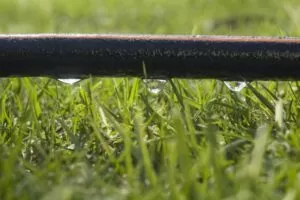FUN FACTS: On dry windy days, a great deal of the water sprayed out of sprinkler systems is lost to evaporation. The loss can be as much as 20%. Sprinklers are often set to work at night when higher humidity and lower temperatures reduce water loss to evaporation.

For most homes, the edge of a slab foundation, often called the grade beam, is 24 to 48 inches deep. (On hillsides and in active soils, grade beams can be as much as 7 feet deep.) Most of a grade beam is buried in the ground. If your irrigation system keeps the top 4, or even 12 inches, of soil wet, it will still not be sufficient to completely protect your foundation.
To protect your foundation from settlement caused by expansive soils that dry and shrink, you must concentrate water along the edge of your foundation and apply enough water to keep the soils damp down 4 to 5 feet. The best way to do foundation watering is by using soaker hoses for foundations (which can be linked to a timer and/or an irrigation system).
Soaker hoses for foundation watering should be placed around your foundation base. It helps to bury them a few inches deep, generally 4 to 6 inches from the edge of your foundation. By burying the soaker hoses, you help to direct the water down and you also help keep the sun from deteriorating your hoses. Soaker hoses must be used more frequently when it is dry and less often when it is wet. It is a good idea to reset the timers on your foundation drip hoses monthly to reflect the weather.
Soaker hoses for foundation watering should not be buried in deep trenches at the bottom of grade beams. Although such positioning will place water exactly where it is needed, there are real hazards associated with leaks. A leaking drip hose, or one that emits water unevenly, can saturate the soils under a grade beam, and adjacent portions of a foundation leading to soils expanding (heaving). Heaving soils are a serious problem that needs to be avoided.
The term soaker hose is a generic term that refers to any type of hose that emits water slowly over the length of the hose. Various types of the best soaker hoses include:
- Coarse surfaced rubber hoses that look like they are made of ground-up rubber. Such hoses allow water to seep out over their entire lengths. Experience has found these are not the best soaker houses for foundations. First, the hoses are easily damaged by sunlight. If left on the surface where they are exposed to direct sunlight, they seem to break down in as little as two years. Second, the openings in the hoses through which water seeps are not evenly sized or spaced. As a result, water might squirt out in one area and seep out slowly in another. Watering tends to be uneven. When buried, the soaker hoses for foundations are easily penetrated by roots. There is a real problem with most of the water coming out in half of a hose nearest to the water source.
- The same type of hose described above, but covered in a tube of permeable plastic cloth. The cloth makes several improvements in this soaker hose for foundations. First, although water comes out of the inner hose unevenly, the cloth tube blocks any jets and helps spread the water more evenly. Second, the cloth tube is more resistant to sunlight, so the hoses last longer. Finally, the cloth helps to keep roots out of the hoses. Though there is still a problem with most of the water coming out of the portion of the hose nearest to the water source, so it’s not the best soaker hose for foundations that you could get.
- Flat hoses, divided into 3 parallel tubes. Each tube of these soaker hoses for foundations has small holes through which water squirts out. One tube has holes in the first third of the hose, the second in the middle third, and the third hose in the last third. The holes are spaced so that water is emitted evenly along the length of the hose. Typically, when water squirts out, it does so in jets that spray water up and out four to seven feet. To be used as a soaker hose for foundations, the hoses must be positioned so that the holes point down.
- Narrow diameter plastic hoses with small openings every 12 to 18 inches. This type of hose is sometimes connected into grids that are buried under sod or in mulch in a garden. The hoses are durable, and when properly installed can be used to water broad areas or narrow areas, such as the edge of a foundation. This type of hose is sometimes referred to as an emitter hose and is one of the best soaker hoses for foundations.
The cost range for soaker hoses for foundations is from about $.36 per foot to $1.00 per foot. Emitter hoses, which are the least costly per foot, do require fittings, which adds to the cost.
If you are seeing cracks in your walls, inside or outside, call the professionals at Advanced Foundation Repair. If you are suffering from seasonal movement that can potentially be addressed by watering, our professionals will let you know.

